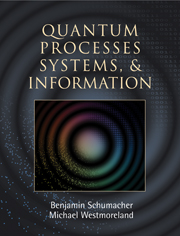Book contents
- Frontmatter
- Contents
- Preface
- 1 Bits and quanta
- 2 Qubits
- 3 States and observables
- 4 Distinguishability and information
- 5 Quantum dynamics
- 6 Entanglement
- 7 Information and ebits
- 8 Density operators
- 9 Open systems
- 10 A particle in space
- 11 Dynamics of a free particle
- 12 Spin and rotation
- 13 Ladder systems
- 14 Many particles
- 15 Stationary states in 1-D
- 16 Bound states in 3-D
- 17 Perturbation theory
- 18 Quantum information processing
- 19 Classical and quantum entropy
- 20 Error correction
- Appendix A Probability
- Appendix B Fourier facts
- Appendix C Gaussian functions
- Appendix D Generalized evolution
- Index
8 - Density operators
Published online by Cambridge University Press: 05 June 2012
- Frontmatter
- Contents
- Preface
- 1 Bits and quanta
- 2 Qubits
- 3 States and observables
- 4 Distinguishability and information
- 5 Quantum dynamics
- 6 Entanglement
- 7 Information and ebits
- 8 Density operators
- 9 Open systems
- 10 A particle in space
- 11 Dynamics of a free particle
- 12 Spin and rotation
- 13 Ladder systems
- 14 Many particles
- 15 Stationary states in 1-D
- 16 Bound states in 3-D
- 17 Perturbation theory
- 18 Quantum information processing
- 19 Classical and quantum entropy
- 20 Error correction
- Appendix A Probability
- Appendix B Fourier facts
- Appendix C Gaussian functions
- Appendix D Generalized evolution
- Index
Summary
Beyond state vectors
We cannot always assign a definite state vector |ψ〉 to a quantum system Q. It may be that Q is part of a composite system RQ that is in an entangled state |Ψ(RQ)〉. Or it may be that our knowledge of the preparation of Q is insufficient to determine a particular state |ψ〉. Consider, for instance, a qubit sent from Alice to Bob during the BB84 key distribution protocol from Section 4.4. The state of this qubit could be |0〉, |1〉, |+〉 or |−〉, each with equal likelihood. In either case – whether Q is a subsystem of an entangled system, or the state of Q is determined by a probabilistic process – we cannot specify a quantum state vector |ψ〉 for Q.
Nevertheless, in either case we are in a position to make statistical predictions about the outcomes of measurements on Q. In this chapter we describe the mathematical machinery for doing this.
Mixtures of states
Suppose the state of Q arises by a random process, so that the state |ψα〉 is prepared with probability pα. The possible states |ψα〉 need not be orthogonal (as you can see in the BB84 example above). We call this situation a mixture of the states |ψα〉, or a mixed state for short.
One way to interpret a mixed state is to return to the idea of an ensemble of systems, which we introduced in Section 3.3.
- Type
- Chapter
- Information
- Quantum Processes Systems, and Information , pp. 158 - 181Publisher: Cambridge University PressPrint publication year: 2010



